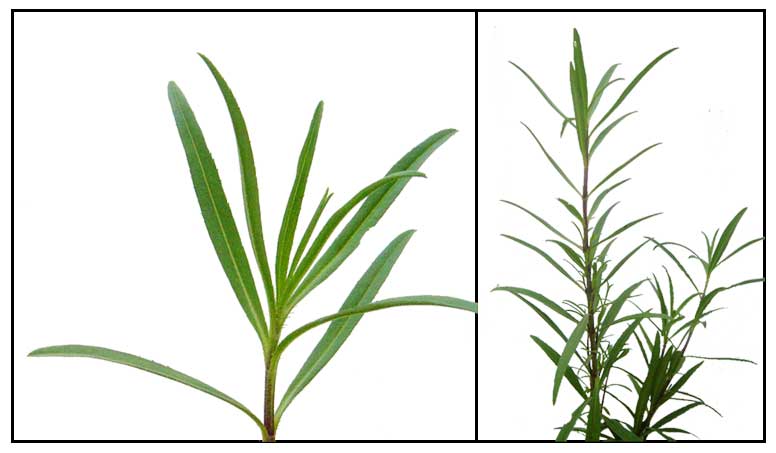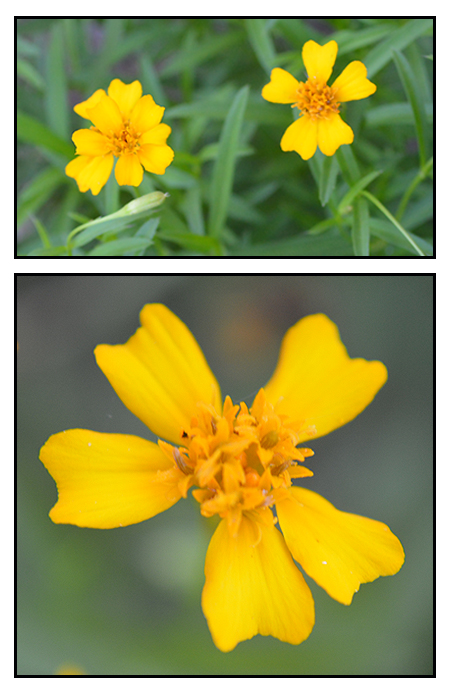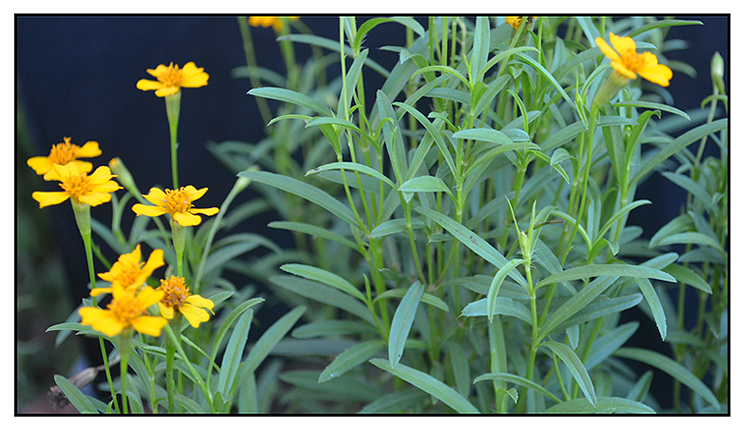
Botany
Tagetes lucida is a perennial
plant growing 40 to 70 centimeters high, usually upright. Leaves are linear to oblong, about 7.5 centimeters long. Flowers are in clusters of yellow flower heads at the ends of stems. Flower heads are about 1.3 centimeters in diameter with 3 to 5 golden yellow ray florets.
 Distribution Distribution
- Cultivated.
- Native to Mexico and Central America.
Constituents
- Chloroform and methanol extracts of aerial parts yielded seven coumarins, 7,8-dihydroxycoumarin (4), umbelliferone (7-hydroxycoumarin) (5), scoparone (6,7-dimethoxycoumarin) (7), esculetin (6,7-dihydroxycoumarin) (11), 6-hydroxy-7-methoxycoumarin (12), herniarin (7-methoxycoumarin) (13), and scopoletin (6-methoxy-7-hydroxycoumarin) (14), and three flavonoids, patuletin (18), quercetin (19), and quercetagetin (20), (see study below) (2)
- Study of essential oil from leaves yielded 78.2% estragole, 3.6% methyleugenol, and 9.4% ß-caryophyllene. Oil from flowers yielded 93.8% estragole, 0.1 methyleugenol, and 2.1% ß-caryophyllene. (Marotti et al 2004)
(6)
- Hydrodistillation of essential oil from fresh flowering aerial parts, flowers, leaves and stems
yielded 30 compounds, of which methyl clavicol (95-97%) was the major constituents. Flower oil yielded two bithienyls as minor constituents. (8)
- Hydrodistillation study of aerial parts for essential oil yielded 53 compounds, with main components of anethole (23.8%), methyleugenol (24.3%), and estragole (33.9%). (15)
Properties
- Leaves have an anise-like flavor.
- Considered digestive, febrifuge, hallucinogenic, hypotensive, narcotic, sedative.
- Studies have shown antimicrobial and antidepressant properties.
Parts utilized
Leaves, flowers.
Uses
Culinary
- Fresh or dried leaves used as tarragon substitute for flavoring soups, sauces, etc.
- Decoction of dried leaves and flower heads made an anise-flavored tea.
- Mexican natives prepare tea using shoots..
- Petals used as condiments.
- Fresh aerial parts sold as substitute for tarragon (Artemisia dracunculus L.).
Folkloric
- No reported folkloric medicinal use in the Philippines.
- Aztecs use tea made from infusion to treat hiccups and diarrhea. Decoction of fresh herbs use to treat stomach pains and abdominal cramps. In Mexico, used to promote lactation; also, added to bath waters to help relieve rheumatic complaints. (5)
- In Argentina, leaf decoction used for coughs and applied to skin as insect repellent.
- Used to treat scorpion bites and to remove ticks.
Others
- Dye: Flowers yield a yellow dye.
- Repellent: Dried plant burned as insect repellent. In Mexico burning of leaves traditionally used as mosquito repellent. (10)
- Ritual: Used by Aztecs in an incense ritual known as Yauhtii. It is an ingredient in a medicinal powder that is blown into faces of those about to become human sacrifice. Also, used by Huichol, mixed with Nicotiana rustica, with claimed psychotropic and entheogenic effects. (4) In Mexico, bundles of dried herbs are used as offerings in temples and sacred sites. Also used in Mexican witchcraft, ceremonial healing, and to dispel diseases. In Mexican Dia de los Muertos celebration (All Saint's Day, First of November), marigolds are traditionally laid out in abundance as offerings on altars. (5)
- Ornamental: In Mexico and Guatemala, flowers are prominently used in religious and indigenous Catholic festivities, especially for All Souls Days, and commonly used for altar and arcs decorations. (9)
Studies
• Antibacterial / Antifungal:
Study of aerial parts yielded seven coumarins and three flavonoids. In addition three coumarin derivatives were synthesized. All the compounds and extracts were assayed against bacteria and fungi. The most active compounds against Gram-positive and -negative bacteria were the dihydroxylated coumarins 3 and 4. Compounds 2-4, 6, 7, and 11 showed interesting activity against V. cholerae. Dimethoxy compounds 6 and 7 showed strong antifungal activity, especially against T. mentagrophytes and R. solani. (see constituents above) (2)
• Antidepressant:
Study evaluated an aqueous extract of T. lucida for antidepressant activity in rats using forced swimming test (FST). Results showed antidepressant activity with significantly reduced immobility and increased swimming without affecting climbing behavior in FST. (3)
• Antimicrobial / Aerial Parts:
Study evaluated T. lucida extracts of aerial parts for antimicrobial properties. A methanol/chloroform extract was active against Aeromonas hominis and Pseudomonas aeruginosa while a chloroform extract also showed activity against E. coli and Enterobacter alcalifaciens. (7)
• Antioxidant / Leaves: A methanol extract yielded a new flavonol glycoside, quercetagenin 3,4'-dimethyl ether 7-O-ß-D-glucopyranosyl-4-methoxtphenyl)propanoic acid and its methyl ester, together with known flavonols, aromatic acids and 7-methoxycoumarin. On DPPH testing, the extract showed significant free radical scavenging effect in comparison to a-tocopherol and standard flavonols. (9)
• Larvicidal Against Aedes Aegypti / Coumarin: Study evaluated extracts and isolated components for larvicidal activity against Ae. aegypti. (10)
• Anti-Inflammatory / Epoxides from Essential Oil: Study evaluated the anti-inflammatory activities of main constituents and epoxides from essential oils of T. lucida, C. citratus, L. alba and E. citriodora. All tested samples inhibited both NO and PGE2 production, but EO from T. lucida and carvone exhibited the highest inhibitory effects. (11)
• Antidepressant Activity / Mechanisms: Study evaluated the participation of the serotoninergic system in the antidepressant-like effect of an aqueous extract of Tagetes lucida. An antidepressant effect was observed on FST with decreased immobility behavior and increased swimming. The effect was blocked by WAY-100635 and PCPA but not by yohimbine and propranolol, suggesting a modulating effect of the extract on release/reuptake of serotonin. (12)
• Cytotoxic Activity: Study evaluated the agent of cytotoxicity from various T. lucida straw extracts. 7-Methoxycoumarin and 6,7-dimethoxycoumarin from a leaf hexanic extract exhibited cytotoxicity in A. salina. The activity was attributed to coumarins. (13)
• Antiplasmodial / Antibacterial / Antioxidant / Leaf Essential Oil: GC-FD and GC-MS analysis of leaf essential oil identified 40 volatile compounds, with estragole (96.8%) as the major component. On DPPH and TBARS screening, the EO showed significant antioxidant capacity. The leaf EO also showed moderated activity against Plasmodium berghei and Escherichia coli. (14)
• Antifungal: Study four plant extracts including Tagetes lucida for antifungal activity. Tagetes lucida, H. longipes, and A ludoviciana inhibited all the fungi assayed viz., Candida albicans, C. lindemuthianum, M. circinelloides, S. cerevisiae, and S. schenckii. The IC50s of aqueous and ethyl acetate extracts from T. lucida against C. albicans, M. circcinelloides and S. schenckii ranged from 11 to 88.7 mg/ml. (16)
Availability
- Cultivated.
- Oil, seeds, dried flowers, tinctures, liquid extracts in the cybermarket.
|




 Distribution
Distribution

